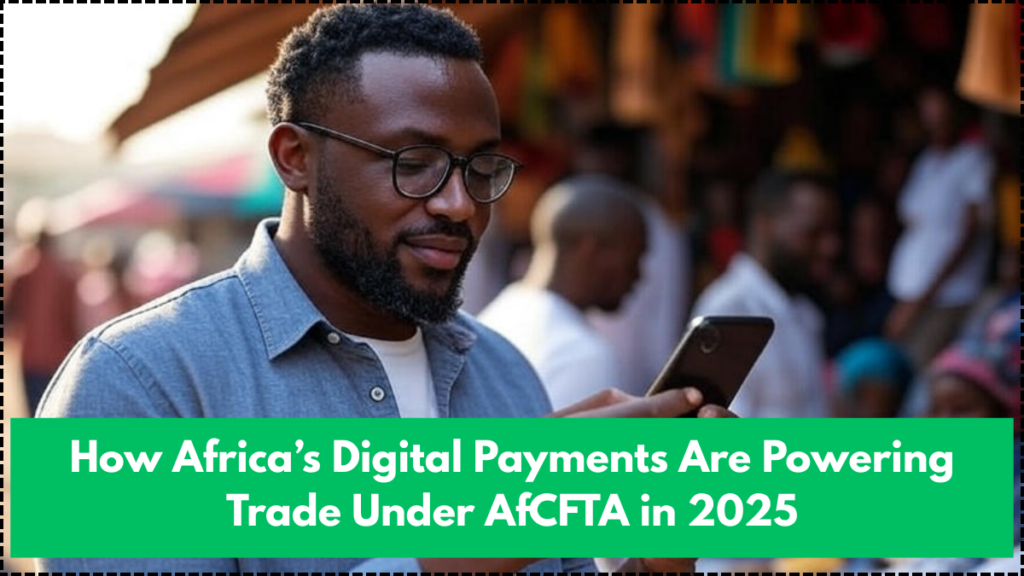AfCFTA digital payments Africa 2025 are no longer a futuristic promise—they’re a living reality transforming how African nations trade. With the African Continental Free Trade Area (AfCFTA) in full swing, cross-border commerce has never been more seamless, thanks to the explosion of fintech-driven digital payment systems. In 2025, this digital backbone is not just an economic asset; it’s a necessity, accelerating intra-African trade and reducing transactional bottlenecks that once plagued the continent.
The rapid growth of Africa trade fintech 2025 solutions is not just about convenience. It’s about reshaping African economies through real-time settlements, mobile wallets, and interoperable platforms that bring everyone—from rural farmers to global manufacturers—into the digital marketplace. From West Africa to the Horn, innovation in digital finance is powering an entirely new trade era.

How AfCFTA Benefits from Fintech-Led Payment Systems
The success of AfCFTA hinges on removing trade barriers—and digital payments are doing exactly that. These platforms now offer:
-
Cross-border payment interoperability
-
Currency conversion tools in real time
-
Fraud protection and compliance features
-
Mobile-first infrastructure for rural markets
Many of these fintech platforms align directly with AfCFTA goals: boosting trade by at least 50% by 2030. And in 2025, progress is already measurable.
Here’s how various countries are integrating digital payment systems within AfCFTA:
| Country | Key Fintech Platforms | Notable Progress in 2025 |
|---|---|---|
| Nigeria | Flutterwave, Paystack | 60% of SMEs now use digital payments for exports |
| Kenya | M-Pesa, Cellulant | Interoperability with East Africa confirmed |
| South Africa | Ozow, Yoco | Real-time B2B settlement with West Africa |
| Ghana | Zeepay, Hubtel | Mobile payments for trade surging in ECOWAS |
The AfCFTA digital payments Africa 2025 movement is no longer about pilot programs. It’s now about regional standardization and open APIs. These tools allow fintech firms to connect across borders, reducing payment friction and foreign exchange complexities.
Challenges Facing Africa’s Fintech Trade Infrastructure
Even as Africa trade fintech 2025 platforms expand, challenges remain. Infrastructure gaps, inconsistent regulations, and limited digital literacy in some areas still create barriers.
Key issues include:
-
Uneven digital infrastructure across rural areas
-
Regulatory lags in harmonizing payment rules
-
Limited financial inclusion in certain communities
-
Cybersecurity threats targeting fintech platforms
Yet the industry is adapting fast. New public-private partnerships are emerging to bridge these gaps. The Pan-African Payment and Settlement System (PAPSS) is now being rolled out to integrate all member states into a unified trade-payment network.
Fintech’s Role in Supporting SMEs and Informal Traders
Small and informal traders are now able to participate in cross-border commerce, thanks to fintech platforms. With AfCFTA digital payments Africa 2025, mobile-first solutions are enabling fast, secure transactions—even without access to traditional banking.
Benefits include:
-
Mobile payment apps that require no bank account
-
Instant verification of trade documentation
-
Buy-now-pay-later options for inventory
-
Real-time tax and customs calculations
This is especially critical for women-led businesses and youth entrepreneurs, who are major drivers of informal trade. With the right fintech tools, their reach now spans entire regions, transforming micro-businesses into continental suppliers.
Future of Digital Trade and Payments in Africa
The future looks promising. By 2030, digital payments are expected to be the backbone of 90% of all intra-African trade. In 2025, fintech firms are working closely with AfCFTA secretariat offices to standardize payment policies, create shared sandboxes for innovation, and reduce reliance on USD settlements.
Key 2025 priorities include:
-
Harmonizing mobile money platforms
-
Digitizing customs and compliance forms
-
Expanding 4G/5G rural connectivity
-
Boosting cybersecurity for cross-border apps
Africa trade fintech 2025 strategies are already delivering real impact, and this synergy between digital payments and regional trade will define the next economic boom across the continent.
Conclusion
AfCFTA digital payments Africa 2025 have become the catalyst for a more integrated, efficient, and inclusive trade ecosystem. By bridging borders through fintech, African nations are turning vision into action. With scalable technologies, robust partnerships, and policy support, the continent is redefining how trade works—from the marketplace to the macroeconomy. As Africa trade fintech 2025 solutions continue to scale, Africa isn’t just catching up—it’s setting the pace.
FAQ
What is the role of digital payments in AfCFTA?
Digital payments simplify cross-border trade by removing barriers like currency conversion and settlement delays, making AfCFTA trade faster and more efficient.
Which African countries are leading in fintech for trade in 2025?
Countries like Nigeria, Kenya, South Africa, and Ghana are leading, thanks to platforms like Flutterwave, M-Pesa, and Zeepay.
How do digital payments support informal trade?
They enable small traders to conduct cross-border business using mobile money, often without needing traditional bank accounts.
Are there any risks with Africa’s fintech trade systems?
Yes. Key risks include cybersecurity threats, inconsistent regulations, and low digital literacy in some regions.
Will fintech reduce the use of the US dollar in African trade?
Yes, as more intra-African payments shift to local currencies, fintech platforms are reducing reliance on USD settlements.
Click here to learn more
Sachin is a dedicated writer specializing in education, career, and recruitment topics, delivering clear and actionable insights to empower readers.
